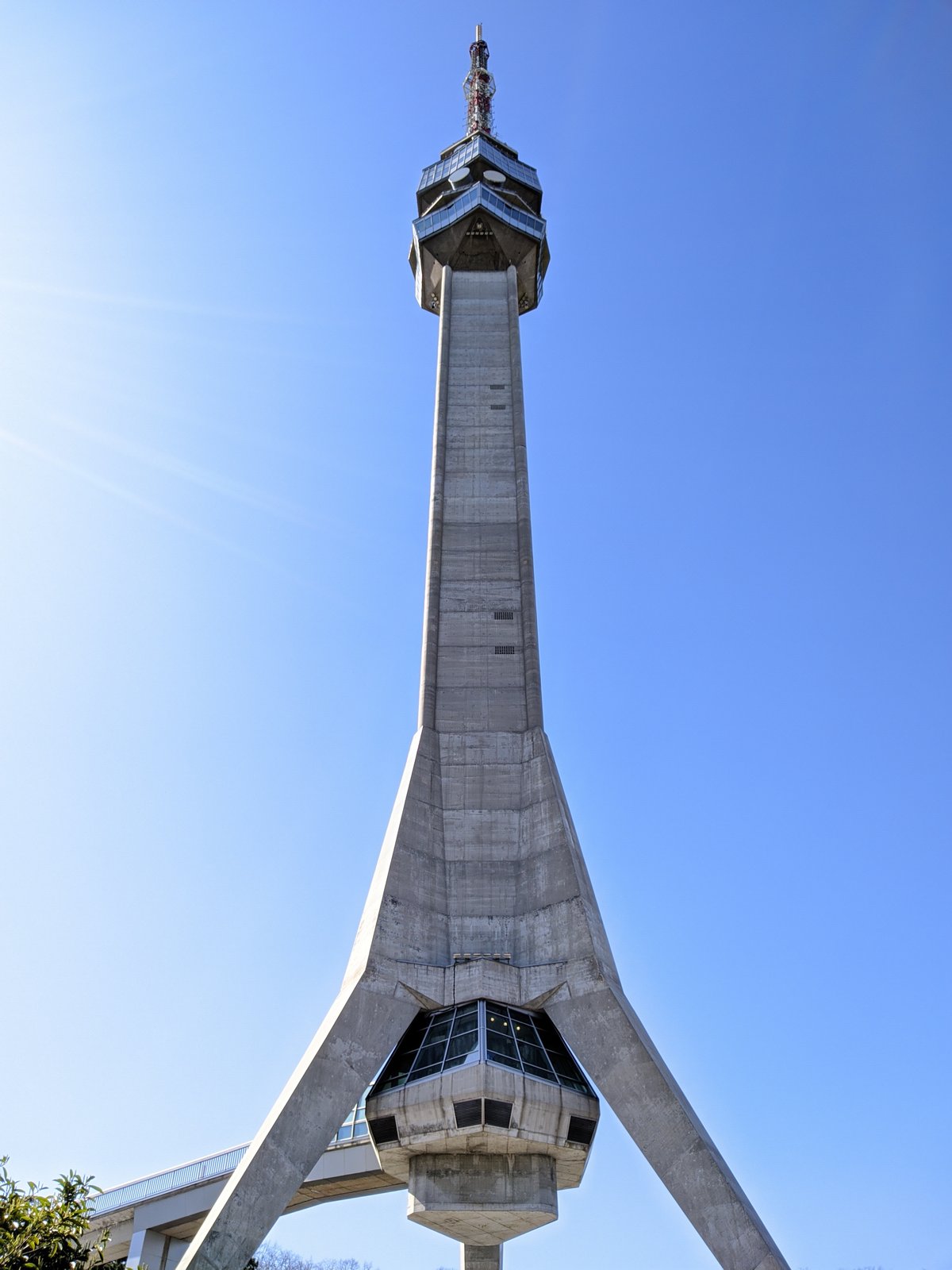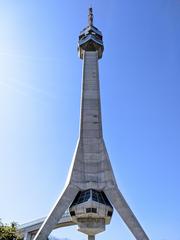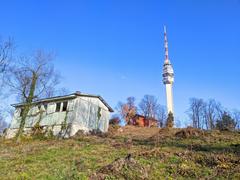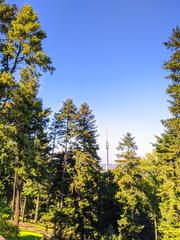
Avala Tower Visiting Hours, Tickets, and Comprehensive Guide to Belgrade’s Iconic Landmark
Date: 14/06/2025
Introduction
Rising above Mount Avala on the outskirts of Belgrade, Avala Tower is more than a telecommunications structure—it is a powerful emblem of Serbian resilience, innovation, and cultural identity. At 204.68 meters, it is the tallest building in the Balkans and a must-see for anyone exploring Belgrade’s architectural and historical landmarks. Originally completed in 1965, the tower’s unique tripod design and triangular cross-section blend traditional Serbian symbolism with modernist engineering (visitbelgrade.eu; e-a-a.com). Its destruction in the 1999 NATO bombing, subsequent reconstruction, and ongoing modernization have cemented its role as a site of national pride and remembrance.
Today, Avala Tower welcomes visitors with panoramic views, a café, family-friendly amenities, and engaging exhibitions. This guide provides detailed information on Avala Tower visiting hours, tickets, accessibility, travel tips, and the rich history and culture surrounding this landmark.
Table of Contents
- Introduction
- Origins and Construction (1961–1965)
- Purpose and Significance
- Destruction and Reconstruction
- The New Avala Tower: Features and Visitor Experience
- Nearby Attractions
- Cultural and National Significance
- Recent Developments
- Frequently Asked Questions (FAQ)
- Practical Visiting Tips
- Conclusion and Call to Action
- References
Origins and Construction (1961–1965)
Avala Tower was conceived during a period of rapid modernization in Yugoslavia, designed by Uglješa Bogunović and Slobodan Janjić, with engineer Milan Krstić. Construction began in 1961 and finished in 1965, resulting in a structure that reached 202.87 meters and featured a distinctive tripod base inspired by the traditional Serbian “tronožac” chair (visitbelgrade.eu; beobuild.rs). The use of reinforced concrete and the equilateral triangle cross-section were engineering innovations of their time.
Purpose and Early Significance
From its inception, Avala Tower served as a critical telecommunications hub, initially enabling black-and-white TV broadcasts, then upgrading to color and eventually supporting Serbia’s first digital terrestrial transmissions. The structure quickly became a national symbol, visible across Belgrade and attracting both locals and tourists (visitbelgrade.eu; balkanwanderlust.com).
Destruction and Reconstruction
On April 29, 1999, Avala Tower was destroyed during NATO airstrikes, leaving a significant void in Serbia’s skyline and national psyche (visitbelgrade.eu; wikipedia.org). Following the war, a widespread movement to rebuild the tower mobilized public and private support. Reconstruction began in 2006, funded by the Republic Property Agency, RTS, and donor contributions totaling approximately 7 million euros (beobuild.rs).
The New Avala Tower: Features and Visitor Experience
The reborn tower was completed in July 2009 and opened to the public in April 2010. While preserving the original’s form, the new tower stands slightly taller at 204.68 meters and incorporates modern safety features, updated telecommunications infrastructure, and enhanced visitor facilities (beobuild.rs; architecturelab.net).
Visiting Hours and Tickets
- Hours: Daily from 10:00 AM to 7:00 PM; check for seasonal changes on the official website.
- Tickets: Adults ~500 RSD; children (7–14) 250 RSD; students/seniors 350 RSD; under 7 free. Discounts and group rates available.
- Purchase: Tickets at the entrance or online via official platforms.
- Accessibility: Elevators and adapted facilities for visitors with disabilities (e-a-a.com).
Getting There
- By Car: 16 km south of Belgrade; ample parking on site.
- By Public Transport: Bus lines 27 or 41 from city center; short walk from bus stop to entrance (Trek Zone).
Visitor Amenities
- Observation Deck: At 122 meters, with 360-degree views over Belgrade, the Danube and Sava rivers, and central Serbia (wander-lush.org).
- Panoramic Café: Refreshments with a view.
- Souvenir Shop: Local crafts, models, and memorabilia.
- Exhibitions: Telecommunications history and cultural displays.
- Family Facilities: Playground, sports fields, outdoor gym.
- Guided Tours: Available on request for deeper insight.
Nearby Attractions
- Monument to the Unknown Hero: A World War I memorial designed by Ivan Meštrović, featuring caryatids and stunning vistas (serbia.com).
- Avala Park: Protected nature area with hiking and picnic spots.
- Ethno Gallery and Restaurant: Serbian cuisine and cultural artifacts.
- Mountain Homes: Mitrovićev dom and Čarapićev brest for dining and accommodation.
- Birth House of Duke Stepa Stepanović: Military Museum in Kumodraž.
Cultural and National Significance
Avala Tower stands as a testament to Serbia’s endurance, serving as both a technological beacon and a site of remembrance. Its presence is felt in national ceremonies, artworks, and daily life. The tower’s tripod design, rooted in tradition, and its historical role as a telecommunications hub highlight Serbia’s balance between heritage and progress (Tourist Organization of Belgrade; iconeye.com).
Recent Developments
Visitor numbers have steadily increased, and the site has been enhanced with decorative lighting, commemorative handprints of notable contributors, and upgraded amenities (architecturelab.net). The tower continues to host educational programs and national commemorations, contributing to community engagement and tourism growth.
Frequently Asked Questions (FAQ)
Q: What are Avala Tower’s visiting hours?
A: 10:00 AM–7:00 PM daily; check the official website for seasonal changes.
Q: How much are tickets?
A: Adults 500 RSD; discounts for children, students, and seniors.
Q: Is the tower accessible?
A: Yes, with elevators and ramps for all visitors.
Q: Are guided tours available?
A: Yes, request at the visitor center or book in advance.
Q: How do I get there from Belgrade?
A: By car, taxi, or bus lines 27/41 from the city center.
Practical Visiting Tips
- Best Time to Visit: Spring and autumn for clear views; early mornings or weekdays for fewer crowds.
- Weather: Dress for wind and changing temperatures on the observation deck.
- Photography: Handheld photography encouraged; tripods may be restricted during peak times.
- Refreshments: Café at the top; full meals at nearby mountain homes or hotel.
- Souvenirs: Available at the base shop.
- Safety: Area is safe and well-maintained.
Conclusion and Call to Action
Avala Tower is a vibrant symbol of Serbia’s history, culture, and innovation—offering breathtaking views, architectural intrigue, and rich storytelling. For travelers, it’s an essential stop near Belgrade, whether for a day trip or a deeper dive into local heritage. For a seamless visit, check Avala Tower visiting hours and ticket options in advance, and make use of resources like the Audiala app for the latest updates, interactive maps, and guided tours.
Download the Audiala app, follow us on social media for travel inspiration, and explore more guides to Belgrade’s top attractions to enrich your journey!
References
- visitbelgrade.eu
- e-a-a.com
- Tourist Organization of Belgrade
- serbia.com
- beobuild.rs
- architecturelab.net
- balkanwanderlust.com
- wikipedia.org
- Trek Zone
- Belgrade Beat
- iconeye.com










































































